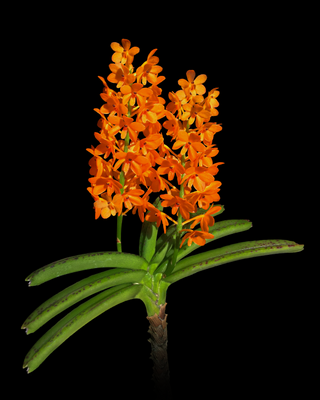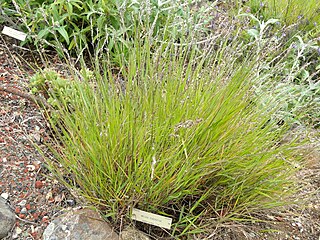
A raceme or racemoid is an unbranched, indeterminate type of inflorescence bearing flowers having short floral stalks along the shoots that bear the flowers. The oldest flowers grow close to the base and new flowers are produced as the shoot grows in height, with no predetermined growth limit. Examples of racemes occur on mustard and radish plants.

A tepal is one of the outer parts of a flower. The term is used when these parts cannot easily be classified as either sepals or petals. This may be because the parts of the perianth are undifferentiated, as in Magnolia, or because, although it is possible to distinguish an outer whorl of sepals from an inner whorl of petals, the sepals and petals have similar appearance to one another. The term was first proposed by Augustin Pyramus de Candolle in 1827 and was constructed by analogy with the terms "petal" and "sepal".

In botany, a bract is a modified or specialized leaf, especially one associated with a reproductive structure such as a flower, inflorescence axis or cone scale. Bracts are usually different from foliage leaves. They may be smaller, larger, or of a different color, shape, or texture. Typically, they also look different from the parts of the flower, such as the petals or sepals. A plant having bracts is referred to as bracteate or bracteolate, while one that lacks them is referred to as ebracteate and ebracteolate, without bracts.

In botany, a glume is a bract below a spikelet in the inflorescence of grasses (Poaceae) or the flowers of sedges (Cyperaceae). There are two other types of bracts in the spikelets of grasses: the lemma and palea.

Sporobolus heterolepis, commonly known as prairie dropseed, is a species of prairie grass native to the tallgrass and mixed grass prairies of central North America from Texas to southern Canada. It is also found further east, to the Atlantic coast of the United States and Canada, but is much less common beyond the Great Plains and is restricted to specialized habitats. It is found in 27 states and four Canadian provinces.

Melica ciliata, the hairy melic or silky spike melic, is a species of flowering plant in the grass family Poaceae, native to Europe, north Africa and temperate Asia. It has been introduced to South Australia.
Melica animarum is a species of grass that is endemic to Sierra de las Ánimas in Uruguay.
Melica bonariensis is a species of grass endemic to Argentina where it can be found in such provinces as Buenos Aires, La Pampa, and Rio Negro.
Melica brasiliana, is a grass species in the family Poaceae that is endemic to Brazil and southern South America.
Melica bocquetii, is a species of grass in the family Poaceae that is endemic to the Subbaetic mountains of southern Spain.

Melica violacea, is a species of grass in the family Poaceae endemic to Chile.

Melica teneriffae, is a grass species in the family Poaceae that is endemic to the Canary Islands.
Melica spartinoides, is a species of grass in the family Poaceae that is endemic to the Brazilian state of Santa Catarina.
Melica serrana, is a species of grass endemic to Cerro de las Ánimas, Uruguay.
Melica stuckertii, is a grass species in the family Poaceae that is endemic to Argentina and southern South America.
Melica dendroides is a grass species in the family Poaceae that is endemic to southern part of Africa.
Melica minor is a species of grass in the family Poaceae. It is endemic to Caucasus.
Melica mollis is a species of grass endemic to Chile where it grows in rock crevices at 340 metres (1,120 ft) above sea level.

Melica penicillaris is a species of grass in the Poaceae family. It is endemic to Inner Anatolia, Turkey, where it grows on bushy hills, rocky slopes, limestone surfaces, and in gullies at 1,000–1,800 metres (3,300–5,900 ft) above sea level.

In botany, floral morphology is the study of the diversity of forms and structures presented by the flower, which, by definition, is a branch of limited growth that bears the modified leaves responsible for reproduction and protection of the gametes, called floral pieces.









